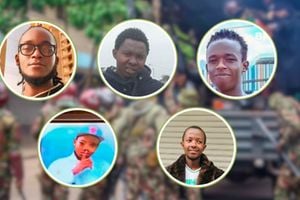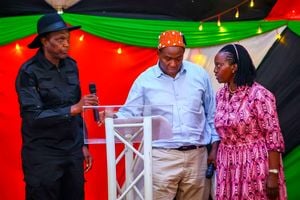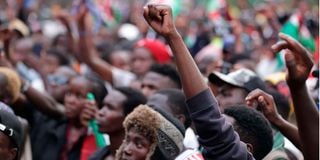
Youth attend Shujaa Memorial Concert at Nyayo Gardens in Nakuru Town on July 28, 2024. The event was held in remembrance of all those who were killed by police during the anti-government protests in the country.
“Strategic Retreat is not surrender”, responds Wanjira Wanjiru to the question of whether the Gen Z protests against high taxation have fizzled out after the climactic storming of Parliament on June 25.
Far from becoming the Kenyan version of the Bastille Day – the key event of the French Revolution on July 14, 1789 – the brief but historic occupation of Parliament was followed by a slowdown in the protests that had shaken President William Ruto’s government to the core.
Read: Kakamega family: Our daughter was found at Kware dumpsite and now police will not let us bury her
The revolution did not happen. The Nane Nane protests of August 8 were nowhere near the scale promised, and in the meantime, President Ruto regained the political initiative by entering into a deal with opposition leader Raila Odinga that gave him a new lease of life.
Whether it is out of protest fatigue, inability to counter the strong security measures or simply being outflanked by the Ruto-Raila union, it does appear the Gen Z revolt has petered out.
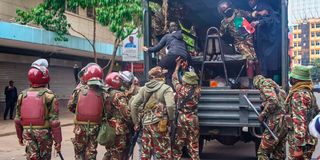
Anti-riot police arrest some protestors along Kimathi Street Nairobi on August 8, 2024, during the youthful protest in the City.
Wanjira Wanjiru, an organiser and one of the most prominent faces and voices of the protests disagrees.
“There have been other forms of resistance in this period. Tulituma salamu (We sent greetings: inundating the phones of selected figures with calls and messages) to the Cabinet Secretary for Defence on abductions; We celebrated #KatibaDay2024 through Kiwake Festival organised by the Social Justice Centre’s Travelling Theatre,” the co-founder of Mathare Social Justice Centre and a veteran of street protests told The Weekly Review.
“The youth continue to do civic and political education in matatus, public spaces and online. There have been pockets of protests. The determination to liberate our country can never die. It only deepens with more clarity on the billionaire club versus the people.”
Akan Simba, 24, who chairs the Kenya Youth Federation, agrees with Wanjira.
The revolt has not lost steam, he insists but has taken time out to reflect and restrategise in the wake of changing political circumstances. There’s a lot of activity taking place behind the scenes, he said, but there’s no need to go public. The movement is also being cautious because of the high risk of infiltration by security agents and continuing efforts to sabotage whatever it is doing.
The big question, though, is whether the Gen Z protests will rise with intensity similar to what was witnessed during the Seven Days of Rage leading up to the storming of Parliament.
Conversations with some of the protest leaders and civil society veterans who have supported the revolt from behind the scenes indicate that there have been discussions on the next course of action.
The initial #RejectFinanceBill protests morphed into #RutoMustGo, but now there is realisation that the President outflanked immediate threats to his rule by incorporating the main opposition party with the appointment of Raila surrogates to the Cabinet.
The union is predicted on countering the GenZ movement and an alliance looking towards Ruto’s re-election campaign for 2027.
The #RutoMustGo remains a catchy clarion call but protest organisers are aware that while they do need to resume activity on the streets, they must also have long-term plans geared towards mobilising a strong youth vote at the next elections.
That means identifying an existing political formation to work with, or forming an entirely youth-led outfit that will represent the hopes and aspirations of the Gen Z movement. On that, there is no hurry as the image of a “leaderless, partyless, tribeless” revolt has served well.
Though there is no formal organisational structure behind the Gen Z revolt, there has been an effective coordination communication structure, and the emergence of key faces like Kasmuel McOure, the eloquent spokesman who has become a fixture on media talk shows and other platforms.
Boniface Mwangi, a veteran just past 40, is another recognisable figure, as is Wanjira who earned celebrity status when videos of her confrontations with police went viral.
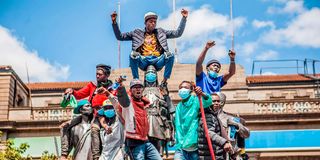
Protesters during the Anti-finance bill demonstrations along Kenyatta Avenue in Nairobi on June 23, 2024.
But it remains a leaderless movement, as Akan explains: “It’s hydra-headed, but there are no specific personalities, activists and influencers who play particular roles.
Everybody has his role in organising or heading specific activities and then giving feedback through our communication channels. Then we organise and agree on how to proceed”.
A key issue occupying the minds of the protest leaders is how to regain the initiative after Ruto stole the thunder, incorporating Raila into the government.
The realignments have changed things. National focus has shifted from issues highlighted by the revolt around taxes, waste and corruption, to the regular mechanics of ethnic political mobilisation.
With Raila by his side, the President now controls government and main opposition troops in Parliament, and has the confidence to ignore the youthful protesters as he consolidates political support with an eye on 2027.
Ruto has also outflanked estranged Deputy President Rigathi Gachagua who is trying to assume leadership of Mt Kenya, a region that played a big role in propelling the Kenya Kwanza regime to power.
Gachagua can now be countered by major regional blocks like Ruto’s Rift Valley teaming with Raila’s Nyanza, Prime Cabinet Secretary Musalia Mudavadi’s Western and Mining Cabinet Secretary Hassan Joho’s Coast.
The challenge for GenZ leaders is to bring back to the table the issues they had initially raised.
Interviews with Wanjira and Akan provide insights into what is taking shape.
Wanjira Wanjiru
On Raila’s deal with Ruto muzzling the protests: “Raila has not impacted Gen Z protests or resistance. Since joining the ‘broad-theft’ government, there have been no fundamental changes on the side of the people. The cost of living is higher. Our politics is issue-based. Raila’s is narrow and tribal. His facade came off during the height of the maandamano demanding good governance. It was clear he was anti-people and chose instead to side with his billionaire class to protect their interests and continue oppressing the people. The political deal served only to agitate us more. We abhor that they are doing. We reject such retrograde moves. With high levels of corruption and a continuous supply of lies from Ruto, maandamano Season Two is inevitable”.

A police officer engages with protesters demonstrating along Kenyatta Avenue in Nairobi during anti-Finance Bill demos on June 25, 2024.
On Gen Z losing the initiative: “Not at all. This is more of a class war than it is ethnic, marking the beginning of the end of tribal politics. Maandamano has everything to do with meritocracy, democracy and good governance, not Raila Odinga. He betrayed the cause and that has made it crystal clear that for him, it has never been about people. This advanced our resolve to end tribalism and focus on socio-economic issues affecting the people of Kenya. Ruto and Raila have no solutions to the issues facing Kenyans. They will not survive the next phase of resistance and determination to bring forth a new Republic of social justice and human rights.”
On whether the “leaderless” movement needs to become a formal institution: “It was a tactic that worked then. Organisation is crucial to continue advancing our course. We are doing this through local people’s assemblies on social issues and building alternative political leadership from the grassroots going up. In Nairobi, we have had people’s assemblies in Mathare, Kibera, Dandora, Dagoretti and Kayole. We are organising through the Occupy People’s Assemblies to take back our country as the people – ward by ward.”
On working with established civil society and political movements: “We understand the importance of working as a collective for we cannot do it alone. We welcome all patriots to the National Coalition, comprising 48 organisations working towards a better Kenya. We have always worked together with progressive civil society organisations defending the Constitution of Kenya and human rights. There are ongoing discussions to support civic and political education sessions, taking mashinani (grassroots) and online.”
On resumption of protests in the coming weeks: “Certainly. Giving birth to a new Kenya will require the efforts of every patriot. Injustice has become law, meaning resistance is the duty of every Kenyan.”
Akan Simba
On President Ruto and Raila Odinga deflating the protests: “After the ‘handshake’, I cannot say it's the opposition Azimio la Umoja One Kenya coalition which influenced people not to go for demonstrations. They were just lucky. It was a coincidence. By the time their broad-based government was formed, we had made the decision to slow down because we learnt of the plan by the government to infiltrate our protest movement. We opted to retreat and restrategise.”
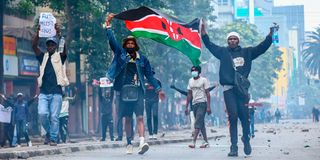
Anti-government protesters hold up the Kenyan flag along Tom Mboya Street on July 2, 2024 during the Occupy Everywhere protests.
On protest fatigue? “No. We are waiting for the right time, including the reopening of universities. Some of us were helping with mobilisation and logistics, so there was a need to regroup. There is a lot of work going on. There are ongoing digital campaigns.”
On the Gen Z Movement transiting to a political organisation: “We have talked about it and it will happen. The priority right now is to continue bringing out the rotten things in government for people to see. Anything can happen before 2027, which is still far. A premature transition to a political organisation will just create room for infiltration and sabotage. Things could begin taking shape by mid-2026.
Another priority is to ensure the mess around the issuing of national identity cards is resolved. Some 12 million young people who have turned 18 still do not have the important document. These are the numbers and votes our movement needs to mobilise.”
On Tisa Tisa protests next month: “No. That won’t happen. We are looking at different strategies, based on targeting specific government ministries. It is people versus ministries. The #RutoMustGo campaign is not redundant? It remains the clarion call because President Ruto is the head that is rotten. It is a long term strategy.”
[email protected]; @MachariaGaitho

